 W
WAirborne Launch Control Centers provide a survivable launch capability for the United States Air Force's LGM-30 Minuteman Intercontinental Ballistic Missile (ICBM) force by utilizing the Airborne Launch Control System (ALCS) onboard which is operated by an airborne missileer crew. Historically, from 1967–1998, the ALCC mission was performed by United States Air Force Boeing EC-135 command post aircraft. This included EC-135A, EC-135C, EC-135G, and EC-135L aircraft.
 W
WThe Airborne Launch Control System (ALCS) provides a survivable launch capability for the United States Air Force's LGM-30G Minuteman III intercontinental ballistic missile (ICBM) force. The ALCS is operated by airborne missileers from Air Force Global Strike Command's (AFGSC) 625th Strategic Operations Squadron (STOS) and United States Strategic Command (USSTRATCOM). The weapon system is located on board the United States Navy's E-6B Mercury, which serves as USSTRATCOM's "Looking Glass" Airborne Command Post (ABNCP). The ALCS crew is integrated into the ABNCP battle staff and is on alert around the clock.
 W
WThe AN/ARC-164 is an aircraft station that operates in the aeronautical mobile (OR) service / B band (NATO). It might be found on B-52G/H, B-1B, C/EC/RC-26D, KC-135, C-23, C-130, C-141, F-15, A-10, F-16, UH-1D, CH-47, H-53, H-60 and S-3B aircraft.
 W
WThe BC-342 was a World War II U.S. Army Signal Corps high frequency radio receiver. It was a 115 Volt AC version of the BC-312 receiver that used the RA-20 rectifier instead of the BC-312's DM-21 dynamotor. It was used primarily as part of field installations such as the SCR-188A, but could be used with mobile sets such as the 2 1/2 ton mounted SCR-399. First designed at Fort Monmouth, New Jersey by the U.S. Army Signal Corps, it was built by various manufacturers including RCA. Many of the later units that are encountered today were manufactured by the Farnsworth Television and Radio Corporation of Fort Wayne, Indiana. Its low frequency counterpart is the BC-344 radio receiver that is almost identical to the BC-342.
 W
WThe BC-348 is a compact American-made communications receiver, which was mass-produced during World War II for the U.S. Army Air Force. Under the Joint Army-Navy nomenclature system, the receiver system became known as the AN/ARR-11.
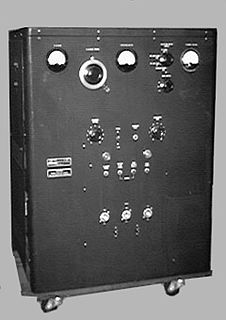 W
WThe BC-610 was a radio transmitter based on the Hallicrafters HT-4 and was used by the U.S. Army Signal Corps during World War II.
 W
WThe Hallicrafters SX-28 "Super Skyrider" was an American shortwave communications receiver produced between 1940 and 1946 that saw wide use by amateur radio, government and military services.
 W
WThe Joint Tactical Radio System (JTRS) aimed to replace existing radios in the American military with a single set of software-defined radios that could have new frequencies and modes (“waveforms”) added via upload, instead of requiring multiple radio types in ground vehicles, and using circuit board swaps in order to upgrade. JTRS has seen cost overruns and full program restructurings, along with cancellation of some parts of the program. JTRS is widely seen as one of the DoD's greatest acquisition failures, having spent $6B over 15 years without delivering a radio.
 W
WThe original National HRO was a 9-tube HF (shortwave) general coverage communications receiver manufactured by the National Radio Company of Malden, Massachusetts, United States.
 W
W W
WNaval Computer and Telecommunications Area Master Station Pacific provides operational direction and management to all Pacific Naval Telecommunication System users. In addition to this function, NCTAMSPAC manages, operates, and maintains Defense Communication System and Naval Telecommunication System assets, and offers a full range of ADP and information resource services, maintenance and repair, and communication/electronic and Defense Message System coordination to the United States Navy and other United States Department of Defense (DoD) activities in the Pacific.
 W
WProject Sanguine was a U.S. Navy project, proposed in 1968 for communication with submerged submarines using extremely low frequency (ELF) radio waves. The originally proposed system, hardened to survive a nuclear attack, would have required a giant antenna covering two fifths of the state of Wisconsin. Because of protests and potential environmental impact, the proposed system was never implemented. A smaller, less hardened system called Project ELF consisting of two linked ELF transmitters located at Clam Lake, Wisconsin and Republic, Michigan was built beginning in 1982 and operated from 1989 until 2004. The system transmitted at a frequency of 76 Hz. At ELF frequencies the bandwidth of the transmission is very small, so the system could only send short coded text messages at a very low data rate. These signals were used to summon specific vessels to the surface to receive longer operational orders by ordinary radio or satellite communication.
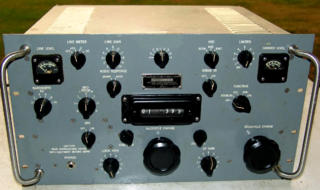 W
WThe R-390A /URR is a general coverage HF radio communications receiver designed by Collins Radio Company for the US military.
 W
WThe Radio tractor was a mobile Signal Corps Radio used by the U.S. Army for ground communications before and during World War I. Prior to World War I, trucks were referred to as "tractors", and there were also telegraph tractors, and telephone tractors.
 W
WThe Radio tractor was a mobile Signal Corps Radio used by the U.S. Army for ground communications before and during World War I. Prior to World War I, trucks were referred to as "tractors", and there were also telegraph tractors, and telephone tractors.
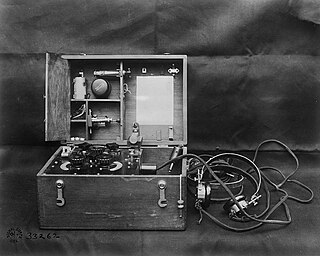 W
WThe SCR-54 was a tunable, portable crystal radio receiver used by the U. S. Army during World War I for fire control in conjunction with airplanes.
 W
WThe SCR-108 Radio Truck was a mobile Signal Corps Radio used by the United States Army during and after World War I for short range air-to-ground communications,
 W
WThe SCR-108 Radio Truck was a mobile Signal Corps Radio used by the United States Army during and after World War I for short range air-to-ground communications,
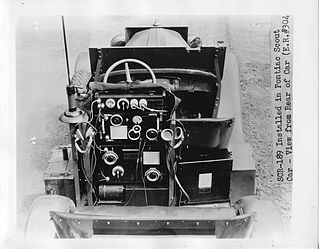 W
WThe SCR-189 was a mobile Signal Corps Radio tested by the United States Army before World War II. It was designed for armored forces, and mounted in the Six Ton Tank M1917. The original production run of these tanks included 50 "radio tanks" but the original radio components are unknown, so what or how many tanks were fitted with the SCR-189 also appears to be unknown.
 W
WThe SCR-189 was a mobile Signal Corps Radio tested by the United States Army before World War II. It was designed for armored forces, and mounted in the Six Ton Tank M1917. The original production run of these tanks included 50 "radio tanks" but the original radio components are unknown, so what or how many tanks were fitted with the SCR-189 also appears to be unknown.
 W
WThe SCR-245 Radio was a mobile MF/HF Signal Corps Radio used by the U.S. Army before and during World War II, for short range ground communications, It was one of the first crystal controlled sets used by the Army.
 W
WThe AN/ARC-5 Command Radio Set is a series of radio receivers, transmitters, and accessories carried aboard U.S. Navy aircraft during World War II and for some years afterward. It is described as "a complete multi-channel radio transmitting and receiving set providing communication and navigation facilities for aircraft. The LF-MF-HF components are designed to transmit and receive voice, tone-modulated, and continuous wave (cw) signals." Its flexible design provided AM radiotelephone voice communication and MCW and CW Morse code modes, all of which are typical capabilities in other Navy aircraft communication sets of the period. It was an improvement of the Navy's ARA/ATA command set. Similar units designated SCR-274-N were used in U.S. Army aircraft. The Army set is based on the ARA/ATA, not the later AN/ARC-5. The ARA/ATA and SCR-274-N series are informally referred to as "ARC-5", despite small differences that render all three series incompatible. Like the AN/ARC-5, the ARA/ATA and SCR-274-N had AM voice communication and two-way MCW and CW Morse code capability.
 W
WThe SCR-277 was a mobile, trailer mounted radio range set for radio guidance of aircraft. It was standardized by the U.S. Army in June 1941.
 W
WThe SCR-284 was a World War II era combination transmitter and receiver used in vehicles or fixed ground stations.
 W
WThe SCR-299 was a U.S. Signal Corps mobile military communications unit used during World War II.
 W
WThe SCR-300 was a portable radio transceiver used by US Signal Corps in World War II. This backpack-mounted unit was the first radio to be nicknamed a "walkie talkie".
 W
WThe SCR-299 was a U.S. Signal Corps mobile military communications unit used during World War II.
 W
WThe SCR-299 was a U.S. Signal Corps mobile military communications unit used during World War II.
 W
WThe SCR-508 radio was a mobile Signal Corps Radio used by the U.S. Army during World War II, for short range ground communications. The SCR-508 series radio represented the Army's commitment to both FM and crystal tuning, and was used extensively by armor and mechanized units. The turret bustle of late series light and medium tanks was designed around this radio.
 W
WThe SCR-508 radio was a mobile Signal Corps Radio used by the U.S. Army during World War II, for short range ground communications. The SCR-508 series radio represented the Army's commitment to both FM and crystal tuning, and was used extensively by armor and mechanized units. The turret bustle of late series light and medium tanks was designed around this radio.
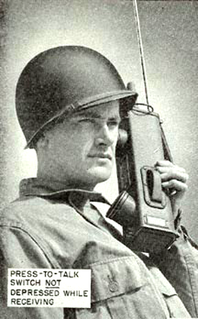 W
WThe SCR-536 was a hand-held radio transceiver used by the US Army Signal Corps in World War II. It is popularly referred to as a walkie talkie, although it was originally designated a "handie talkie".
 W
WThe SCR-508 radio was a mobile Signal Corps Radio used by the U.S. Army during World War II, for short range ground communications. The SCR-508 series radio represented the Army's commitment to both FM and crystal tuning, and was used extensively by armor and mechanized units. The turret bustle of late series light and medium tanks was designed around this radio.
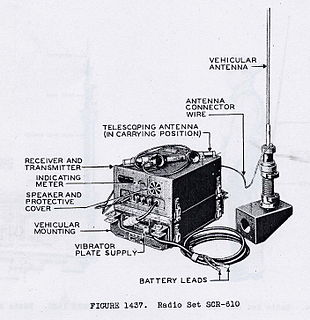 W
WThe SCR-610 was a Signal Corps Radio used by the U.S. Army during and after World War II, for short range ground communications, it was standardized 29 Sept. 1941,
 W
WThe SCR-610 was a Signal Corps Radio used by the U.S. Army during and after World War II, for short range ground communications, it was standardized 29 Sept. 1941,
 W
WThe SCR-508 radio was a mobile Signal Corps Radio used by the U.S. Army during World War II, for short range ground communications. The SCR-508 series radio represented the Army's commitment to both FM and crystal tuning, and was used extensively by armor and mechanized units. The turret bustle of late series light and medium tanks was designed around this radio.
 W
WThe SCR-694 was a portable two way radio set used by the U.S. military during World War II.
 W
WSignal Corps Radios were U.S. Army military communications components that comprised "sets". Under the Army Nomenclature System, the abbreviation SCR initially designated "Set, Complete Radio", but was later misinterpreted as "Signal Corps Radio."
 W
WSingle Channel Ground and Airborne Radio System (SINCGARS) is a Combat Net Radio (CNR) currently used by U.S. and allied military forces. The CNR network is designed around three systems: SINCGARS, the high frequency (HF) radio, and the SC tactical satellite (TACSAT). Each system has different capabilities and transmission characteristics. SINCGARS is a family of user-owned and operated, very high frequency-frequency modulation (VHF-FM) CNRs. As a part of the CNR network, the SINCGARS’ primary role is voice transmission for command and control (C2) between surface and airborne C2 assets. SINCGARS can transmit and receive secure data and facsimile transmissions through simple connections with various data terminal equipment.
 W
WTACAMO is a United States military system of survivable communications links designed to be used in nuclear warfare to maintain communications between the decision-makers and the triad of strategic nuclear weapon delivery systems. Its primary mission is serving as a signals relay, where it receives orders from a command plane such as Operation Looking Glass, and verifies and retransmits their Emergency Action Messages (EAMs) to US strategic forces. As it is a dedicated communications post, it features the ability to communicate on virtually every radio frequency band from very low frequency (VLF) up through super high frequency (SHF) using a variety of modulations, encryptions and networks, minimizing the likelihood an emergency message will be jammed by the enemy. This airborne communications capability largely replaced the land-based extremely low frequency (ELF) broadcast sites which became vulnerable to nuclear strike.
 W
WTactical Vest Antenna System (TVAS) is a type of wearable antenna designed for use by the United States Armed Forces. It is claimed that troops equipped with the TVAS are more effective than traditional whip antenna-equipped troops due to better concealment of the equipment and mobility improvement to the operator. TVAS was developed by Wearable Antenna Technologies Inc. in early 2008.
 W
WThe U-229 is a cable connector currently used by the U.S. military for audio connections to field radios, typically for connecting a handset. There are five-pin and six-pin versions. This type of connector is also used by the National Security Agency to load cryptographic keys into encryption equipment from a fill device.
 W
WThis is a list of vehicles used by the U.S. Army Signal Corps from World War I through World War II.
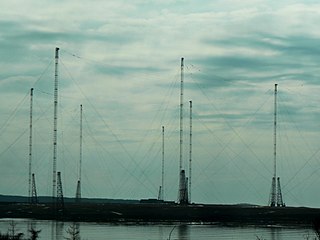 W
WThe VLF Transmitter Cutler is the United States Navy's very low frequency (VLF) shore radio station at Cutler, Maine. The station provides one-way communication to submarines in the Navy's Atlantic Fleet, both on the surface and submerged. It transmits with call sign NAA, at a frequency of 24 kHz and input power of up to 1.8 megawatts, and is one of the most powerful radio transmitters in the world.